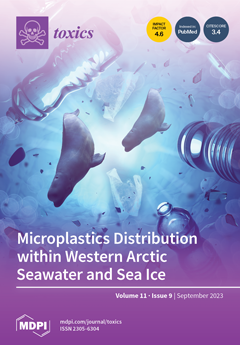Chronic diseases of the urogenital tract, such as bladder cancer, prostate cancer, reproductive disorders, and nephropathies, can develop under the effects of chemical hazards in the working environment. In this respect, nanosized particles generated as by-products in many industrial processes seem to be
[...] Read more.
Chronic diseases of the urogenital tract, such as bladder cancer, prostate cancer, reproductive disorders, and nephropathies, can develop under the effects of chemical hazards in the working environment. In this respect, nanosized particles generated as by-products in many industrial processes seem to be particularly dangerous to organs such as the testes and the kidneys. Nephrotoxicity of element oxide particles has been studied in animal experiments with repeated intraperitoneal injections of Al
2O
3, TiO
2, SiO
2, PbO, CdO, CuO, and SeO nanoparticles (NPs) in total doses ranging from 4.5 to 45 mg/kg body weight of rats. NPs were synthesized by laser ablation. After cessation of exposure, we measured kidney weight and analyzed selected biochemical parameters in blood and urine, characterizing the state of the excretory system. We also examined histological sections of kidneys and estimated proportions of different cells in imprint smears of this organ. All element oxide NPs under investigation demonstrated a nephrotoxic effect following subchronic exposure. Following the exposure to SeO and SiO
2 NPs, we observed a decrease in serum creatinine and urea, respectively. Exposure to Al
2O
3 NPs caused an increase in urinary creatinine and urea, while changes in total protein were controversial, as it increased under the effect of Al
2O
3 NPs and was reduced after exposure to CuO NPs. Histomorphological changes in kidneys are associated with desquamation of the epithelium (following the exposure to all NPs except those of Al
2O
3 and SiO
2) and loss of the brush border (following the exposure to all NPs, except those of Al
2O
3, TiO
2, and SiO
2). The cytomorphological evaluation showed greater destruction of proximal sections of renal tubules. Compared to the controls, we observed statistically significant alterations in 42.1% (8 of 19) of parameters following the exposure to PbO, CuO, and SeO NPs in 21.1% (4 of 19)—following that, to CdO and Al
2O
3 NPs—and in 15.8% (3 of 19) and 10.5% (2 of 19) of indicators, following the exposure to TiO
2 and SiO
2 nanoparticles, respectively. Histomorphological changes in kidneys are associated with desquamation of epithelium and loss of the brush border. The cytomorphological evaluation showed greater destruction of proximal sections of renal tubules. The severity of cyto- and histological structural changes in kidneys depends on the chemical nature of NPs. These alterations are not always consistent with biochemical ones, thus impeding early clinical diagnosis of renal damage. Unambiguous ranking of the NPs examined by the degree of their nephrotoxicity is difficult. Additional studies are necessary to establish key indicators of the nephrotoxic effect, which can facilitate early diagnosis of occupational and nonoccupational nephropathies.
Full article






